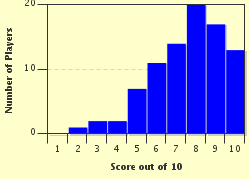Quiz Answer Key and Fun Facts
1. Arrrrr, me bucko! I am a swaggering buccaneer who smacks me blade heartily at yer wee round shield, swaggering with noisy braggadocio! Are ye afeared? I know you are, but what am I?
2. Ouch! You conked me on the head with your conker! No fair! Mom!!! The source of ammunition for the British schoolyard game conkers is a species of tree from the genus Aesculus, sometimes called the horse chestnut. What common name is used for a species of this genus that grows in North America and is especially associated with Ohio?
3. Zut alors! Fetchez la vache! I'm going ballistic! This English spelling is sometimes used in place of a similar French word to describe a siege engine that can throw big objects over a castle wall. Can you recognize this obscure word for a catapult?
4. Great Buckyballs, Batman! This structure is defined as "a truncated icosahedron with 60 vertices and 32 faces (20 hexagons and 12 pentagons where no pentagons share a vertex) with a carbon atom at the vertices of each polygon and a bond along each polygon edge"; that is, it's shaped like a soccer ball or a geodesic dome. What is the name of this spherical molecule?
5. Leapin' Lizards, Daddy Warbucks! That's a lot of moolah! If her rich foster father gave Little Orphan Annie a sawbuck, how much money would she have?
6. Hey! I'm riding shotgun! Mom! Around 1830, Cyrus Comstock, a traveling preacher from New York, built a horse-drawn vehicle with a simple suspension system that could handle the rough terrain of the Adirondack Mountains. What was this conveyance, essential to farmers and settlers of the American west throughout the 19th century?
7. A doe, a deer, a female deer...not! What is the name of a male of the species Capreolus capreolus, a ship sailed and lost in 1701 by a former buccaneer named William Dampier, a bay in Western Australia, and a watch repairman who went into business with Richard Warren Sears in 1886?
8. What's for breakfast? Oh, that's groats! What "ancient grain" is not a grain of the grass family like wheat but a seed that is healthy and filling served as the main ingredient of pancakes, noodles, or "kasha" (porridge)?
9. It's a bucking bronco! No, it's not. What is that animal? The word "buck" (related to Dutch "bok" or German "bock" or the Old English "bucca" for a male goat) often is used to denote a species of animal, not just a male, and this was especially true in Africa, when English and Dutch settlers stuck names on the fauna. But which of these is not an African antelope and owes its name to a different source entirely?
10. Buckle down, Old Buckhound! Time to remember those things you always wanted to do and DO them before you kick the bucket. What's the 21st century idiom for this sort of project?
Source: Author
nannywoo
This quiz was reviewed by FunTrivia editor
agony before going online.
Any errors found in FunTrivia content are routinely corrected through our feedback system.

